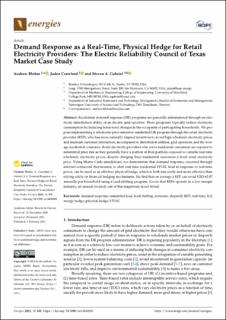| dc.contributor.author | Blohm, Andrew | |
| dc.contributor.author | Crawford, Jaden | |
| dc.contributor.author | Gabriel, Steven Adam | |
| dc.date.accessioned | 2021-02-22T08:51:07Z | |
| dc.date.available | 2021-02-22T08:51:07Z | |
| dc.date.created | 2021-02-19T10:29:12Z | |
| dc.date.issued | 2021 | |
| dc.identifier.citation | Energies. 2021, 14 (4), . | en_US |
| dc.identifier.issn | 1996-1073 | |
| dc.identifier.uri | https://hdl.handle.net/11250/2729381 | |
| dc.description.abstract | Residential demand response (DR) programs are generally administered through an electricity distribution utility, or an electric grid operator. These programs typically reduce electricity consumption by inducing behavioral changes in the occupants of participating households. We propose implementing a wholesale-price-sensitive residential DR program through the retail electricity provider (REP), who has more naturally aligned incentives to avoid high wholesale electricity prices and maintain customer satisfaction, as compared to distribution utilities, grid operators, and the average residential consumer. Retail electricity providers who serve residential consumers are exposed to substantial price risk as they generally have a portion of their portfolio exposed to variable real-time wholesale electricity prices, despite charging their residential customers a fixed retail electricity price. Using Monte Carlo simulations, we demonstrate that demand response, executed through internet-connected thermostats, to shift real-time residential HVAC load in response to real-time prices, can be used as an effective physical hedge, which is both less costly and more effective than relying solely on financial hedging mechanisms. We find that on average a REP can avoid USD 62.07 annually per household using a load-shifting program. Given that REPs operate in a low margin industry, an annual avoided cost of this magnitude is not trivial. | en_US |
| dc.language.iso | eng | en_US |
| dc.publisher | MDPI | en_US |
| dc.rights | Navngivelse 4.0 Internasjonal | * |
| dc.rights.uri | http://creativecommons.org/licenses/by/4.0/deed.no | * |
| dc.title | Demand Response as a Real-Time, Physical Hedge for Retail Electricity Providers: The Electric Reliability Council of Texas Market Case Study | en_US |
| dc.type | Peer reviewed | en_US |
| dc.type | Journal article | en_US |
| dc.description.version | publishedVersion | en_US |
| dc.source.pagenumber | 16 | en_US |
| dc.source.volume | 14 | en_US |
| dc.source.journal | Energies | en_US |
| dc.source.issue | 4 | en_US |
| dc.identifier.doi | 10.3390/en14040808 | |
| dc.identifier.cristin | 1891642 | |
| dc.description.localcode | This is an open access article distributed under the Creative Commons Attribution License which permits unrestricted use, distribution, and reproduction in any medium, provided the original work is properly cited | en_US |
| cristin.ispublished | true | |
| cristin.fulltext | original | |
| cristin.qualitycode | 1 | |

